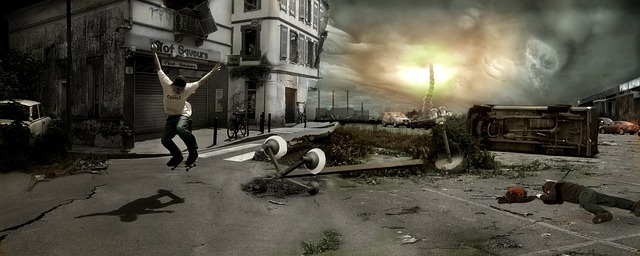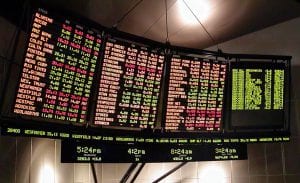
How to Invest When the Stock Market Crashes: Embrace Fear, Buy Opportunity
Updated April 23, 2024
Introduction: Unveiling the Timeless Truth
“Why Did the Stock Market Crash Today?” This question resonates across Wall Street and echoes globally with each market downturn. As we delve into it, the answer is intricately tied to a perennial aspect of human nature: greed.
Greed, an enduring force within us, significantly shapes the financial landscape. The quest for excessive wealth has spawned speculative bubbles and market crashes. From the Dutch Tulip Mania in the 17th century to the dot-com bubble of the late 1990s, the fingerprints of greed linger on the remnants of financial catastrophes.
Stock market crashes are complex events often attributed to factors beyond human emotions like greed. While pursuing wealth can lead to speculative bubbles that eventually burst, modern market dynamics are shaped by many elements.
Technological advancements have introduced high-frequency trading and algorithms that can exacerbate market movements, increasing volatility. The global interconnectedness of markets means that an event in one corner of the world can have ripple effects worldwide, affecting investor sentiment and market stability.
Social media now plays a significant role in the financial markets, with the potential to rapidly influence investor behaviour and move markets through the widespread dissemination of information, rumours, or opinions.
Economic indicators such as GDP growth, interest rates, and corporate earnings are critical in assessing the market’s health. Geopolitical events can introduce uncertainty, affecting global markets and investor confidence.
The Essence of Market Crashes: Insights from Investing Legends
Stock market crashes can be understood through the wisdom of investing legends like John Bogle and Charlie Munger and the insights of strategic thinkers like Niccolò Machiavelli and the Stoic philosopher Seneca.
John Bogle warned against the pursuit of quick profits through speculative trading, believing it leads to greater market instability. Bogle’s philosophy suggests that the relentless pursuit of wealth without regard for intrinsic value creates an environment ripe for a crash, as seen in the 2008 financial crisis.
Charlie Munger emphasizes the limits of our knowledge and the irrationality of markets. His concept of ‘Lollapalooza effects’ – the confluence of multiple biases and psychological tendencies – can contribute to market excesses and subsequent crashes, as exemplified by the Dot-Com Bubble.
Niccolò Machiavelli might interpret a market crash as a manifestation of the human struggle for power and control, where influential players manipulate situations for personal gain, as seen in the 1980s insider trading scandals.
Seneca’s Stoic teachings on the impermanence of fortune align with the cyclical nature of financial markets. He would counsel investors to prepare for downturns as natural occurrences, as the 1929 and 2000 crashes remind us that periods of growth often precede dramatic falls.
These thinkers highlight how human behaviours like greed and pursuing power, combined with modern market forces, can lead to sudden downturns. The Dot-Com Bubble exemplifies a speculative bubble driven by the allure of rapid gains, leading to excessive valuations disconnected from economic fundamentals. Its collapse exposed the fragility of many businesses and the risks of speculation.
Understanding market crashes requires acknowledging the interplay between human psychology, particularly fear and greed, and the economic environment. Recognizing this can lead to a more nuanced perspective on the causes and consequences of financial upheavals.
Case Study: The Dot-Com Bubble
The Dot-Com Bubble of the late 1990s is a textbook case of a speculative bubble driven by the allure of the burgeoning internet sector. Investors, chasing rapid gains, funnelled capital into internet companies, leading to excessive stock valuations. This period of speculative investment came to a head when the bubble burst, resulting in a significant market downturn.
Speculation was rampant during this time, with the internet as a transformative force for business and wealth creation. Start-ups, often without profits, garnered massive investments, leading to sky-high valuations. The fear of missing out prompted investors to overlook established valuation methods, choosing instead to invest in any venture with an Internet angle.
The stock prices of technology companies have reached unprecedented levels, disconnecting from the economic fundamentals. The Nasdaq Composite Index, heavily weighted with tech stocks, symbolised this overvaluation. By early 2000, the market began to correct, and the decline was steep.
The bubble’s collapse exposed the fragility of many Internet businesses, revealing unsustainable business models and a lack of profitability. The swift change in market sentiment triggered a widespread sell-off, causing the stock market to crash. The fallout was severe, with many once-promising companies failing, and served as a stark reminder of the risks associated with speculative investment and the importance of due diligence in stock valuation.
Case Study: The Crash of 1929
The 1929 stock market crash, also known as Black Tuesday, marked the beginning of the Great Depression. Key factors included rampant speculation, overvalued stocks, and lack of regulatory oversight. The 1920s saw a stock market boom fueled by liberal credit and optimism, with investors heavily borrowing to invest, creating a speculative bubble.
On October 24, 1929, panic ensued as investors rushed to sell their stocks. The collapse on Black Tuesday wiped out significant wealth and led to widespread bank and business failures, triggering a prolonged economic downturn. This event led to substantial financial reforms, including establishing the Securities and Exchange Commission, highlighting the need for strict financial regulation.
Case Study: The COVID Crash
The COVID-19 pandemic initiated a unique stock market crash in early 2020. Unlike typical financial-driven crashes, this was spurred by an external health crisis causing global economic shutdowns. The rapid virus spread and lockdowns disrupted businesses and supply chains, creating market uncertainty.
Investors liquidated their holdings, causing a sharp downturn, particularly impacting sectors like travel and hospitality. However, the market showed resilience as governments and central banks implemented fiscal and monetary measures to stabilize the economy. The crash underscored the market’s vulnerability to external shocks and emphasized the importance of risk management and investment diversification. It also accelerated digitalization, opening new investment opportunities in technology and healthcare.
Case Study: The Housing Market Crash of 2008
The 2008 Housing Market Crash had a profound economic impact, driven by aggressive lending, a housing bubble, and complex financial derivatives. A surge in housing demand and rising prices led to relaxed lending standards, with subprime mortgages issued to unqualified buyers, inflating the housing bubble. When the bubble burst, many faced mortgages that exceeded their home’s value, leading to defaults and foreclosures.
Financial instruments like mortgage-backed securities tied to these risky loans lost value, causing significant losses at financial institutions and a global recession. The crash highlighted the dangers of speculative excess and led to stricter financial regulations, reshaping economic policies and regulatory frameworks.
Case Study: The Flash Crash of 2010
The May 6, 2010, Flash Crash was a brief yet extreme market event where U.S. stock indices plummeted and quickly recovered within minutes. This crash underscored the fragility of financial markets in the face of high-frequency and algorithmic trading.
Automated trading algorithms reacted to market conditions and initiated a sell-off, spiralling into a steep market decline. The interplay of these algorithms, selling in a feedback loop, exacerbated the market’s volatility.
In response to the crash, regulatory measures were introduced to prevent such occurrences, including improved circuit breakers and trading pauses during extreme volatility. The Flash Crash is an exemplary example of the potential risks of automated trading systems and the importance of regulatory safeguards and human oversight.
Greed, Market Crashes, and Investment Philosophy: Munger, Buffett, and Lynch
The recurring theme of today’s market crashes can often be traced back to the fundamental human emotion of greed, a sentiment that has historically led to speculative bubbles and financial crises. The pattern of overvaluation and speculative investment we see today echoes the Dot-Com Bubble and other past market excesses, highlighting the persistent role of greed in the financial markets.
Warren Buffett’s principle of exercising caution when others are greedy is particularly relevant in today’s volatile market environment. His approach suggests that market psychology, driven by greed, can lead to inflated asset bubbles bound to collapse. Buffett’s long-standing partner, Charlie Munger, adds to this narrative by pointing out that envy and greed fuel the financial world’s speculative nature. Munger’s emphasis on recognizing harsh realities serves as a crucial guidepost in navigating market downturns, advocating for a clear-eyed assessment of market conditions to make informed investment decisions.
Peter Lynch’s investment philosophy advises investors to “invest in what you know,” implying that greed often tempts investors to abandon rationality and chase speculative gains. His advice reminds him of the importance of a disciplined, research-based investment strategy to counteract the distorting effects of greed.
Conclusion: The Intertwined Nature of Markets and Emotions
In exploring the reasons behind a stock market crash, we find ourselves amidst a complex interplay of quantitative data and human sentiment. Each rise and fall, each period of prosperity or decline, mirrors the collective mood of investors. The stock market, in its essence, is not just a measure of economic vitality but a canvas where human emotions like greed, fear, and optimism paint a vivid picture.
Ultimately, the market reflects our shared aspirations and anxieties, with our relentless pursuit of wealth often at the centre. The persistent question, “Why did the stock market crash today?” is thus a testament to the enduring presence of greed within the human condition.
This realization transcends mere financial analysis, prompting us to consider the deeper, more intrinsic aspects of our nature that influence the financial markets. It is a revelation that connects the dots between the mechanics of trading and the psychology of traders, offering a profound understanding of the eternal interplay between human emotion and economic phenomena.
Uncover the Extraordinary: Must-Reads
Japan’s Economy: Abe Mulling Another Round of Stimulus
Zero Percent Mortgages Debut: Setting the Stage for Next Bull Market
Brexit’s Currency Wars: Hidden Theme for Financial Freedom
Surviving the Bear Stock Market: What’s New for Investors?
Fed Interest Rate: Negative Rates Are A Game Changer
What Economic Recovery? Most Americans Lack $1000 In Savings
Federal Reserve Interest Rate: Dangers & Benefits of Negative Rates

Why Are Interest Rates So Low: Coronavirus That’s Why
CAT Stock Price Projections And Future Trends
Why own gold in uncertain times: Protection From Disaster
HD stock quote And future price trends
Valeant Shares Slump

End Of Bull Market: Masses Worry Higher Rates Will Kill This Bull
Why Global Warming Is A Hoax & How Oil Giants Are Feeling The Heat
Nuclear Waste Management Market
Graceful Money Moves: 6 Powerful Tips on How to Manage Your Money


